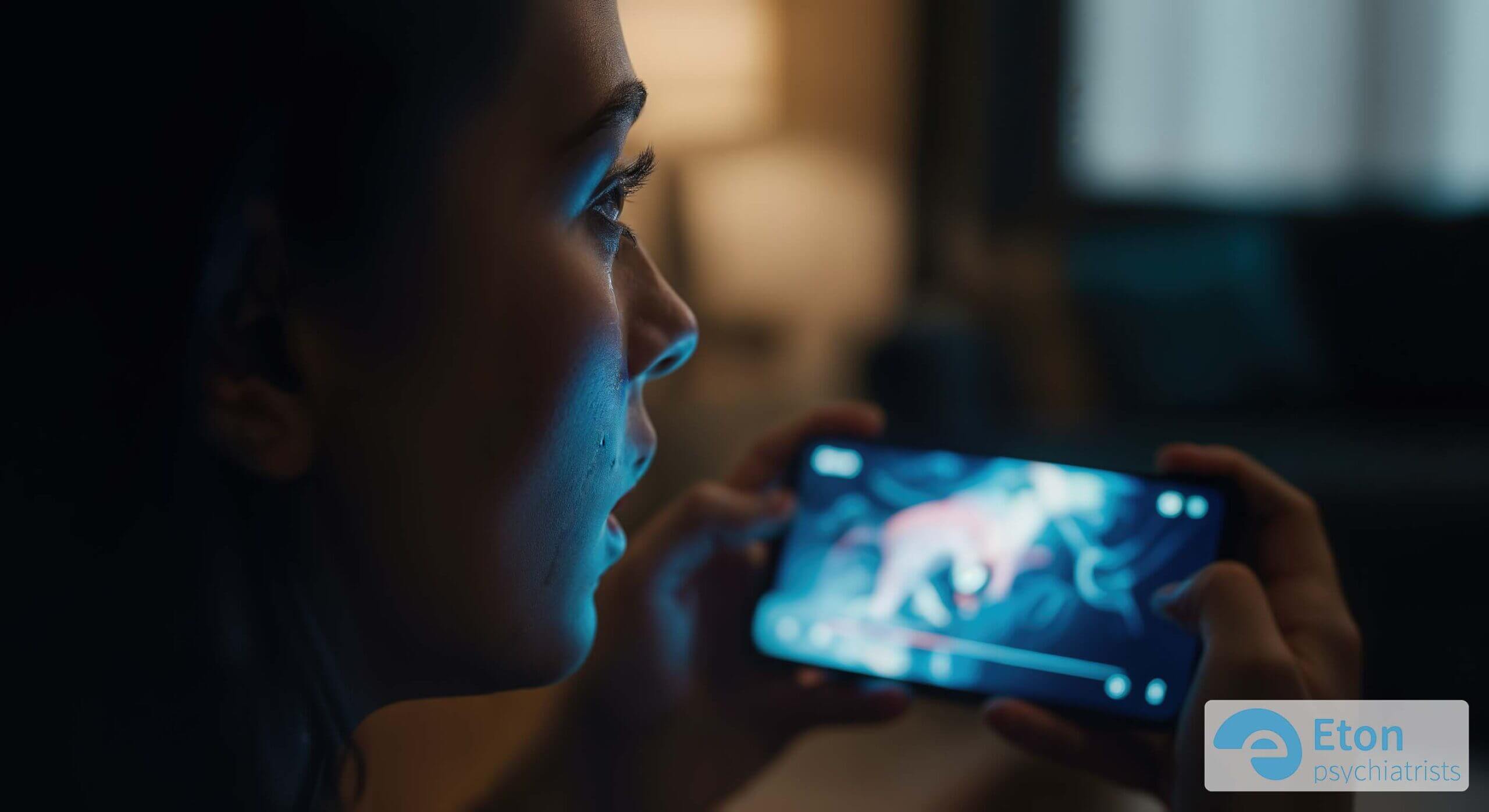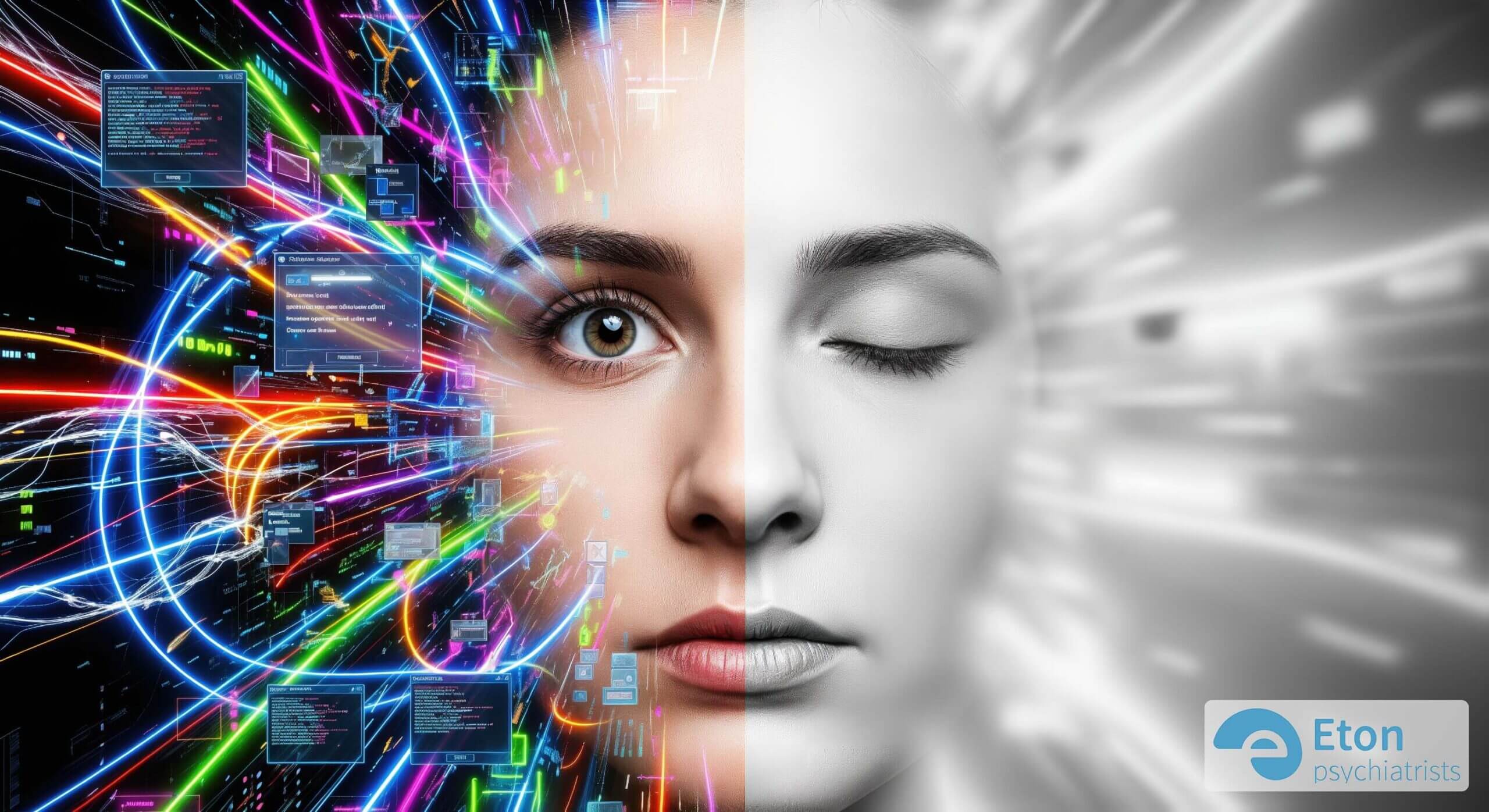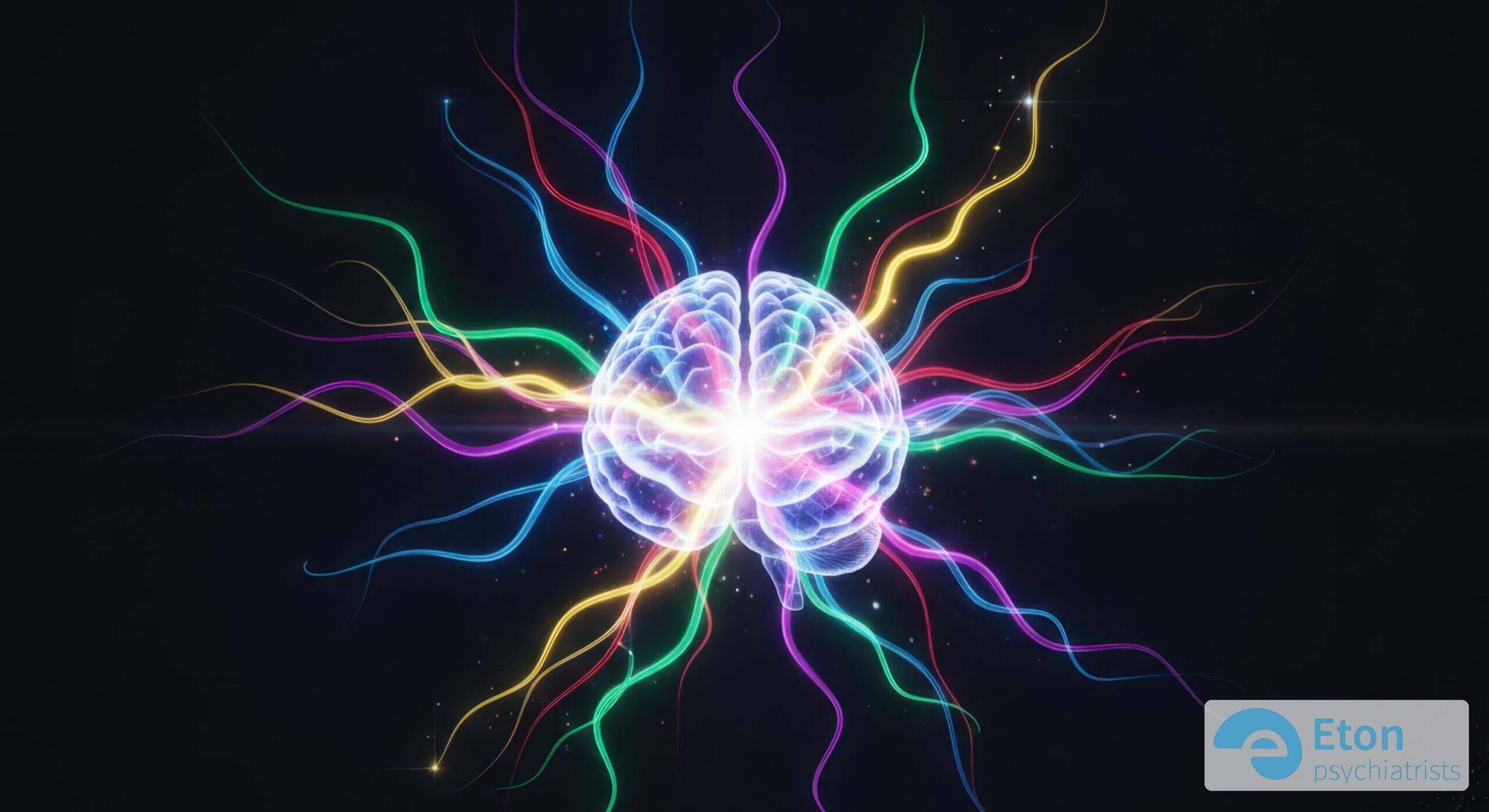
ADHD and Autism: Navigating the Social Media World
Listen to the Article
For those on the go or who prefer listening, you can play the full audio version of this deep dive below.

For many neurodivergent individuals, the digital world is a paradox. Social media can feel like a lifeline by offering a vibrant space for connection and understanding that may be hard to find offline. Yet, it can also be a source of profound sensory overload, anxiety, and distraction. This complex relationship between ADHD, autism, and social media isn’t just a trend; it’s a defining feature of modern life for millions. It presents both incredible opportunities for community and significant challenges to mental well-being.
This guide, created by the clinical team at Eton Psychiatrists, aims to provide a balanced perspective. We will explore the benefits, unpack the risks, and offer practical, evidence-based strategies to help you navigate these platforms. Our goal is to empower you to transform your social media use from a passive, often overwhelming, experience into a mindful and genuinely supportive one.
Table of Contents
- A Digital Paradox: Finding Your Tribe vs. Navigating the Noise
- The TikTok Effect: The Rise of Self-Diagnosis and Misinformation
- “AuDHD” and Social Media: Understanding the Combined Experience
- From Mindless Scrolling to Mindful Engagement
- A Guide for Parents and Carers
- Why Trust Eton Psychiatrists?
- The Importance of Professional Guidance
- Summary
- Sources
- Frequently Asked Questions
A Digital Paradox: Finding Your Tribe vs. Navigating the Noise
The intense appeal of autism social media communities and ADHD social media spaces lies in their power to validate personal experiences. For someone who has spent years feeling different or misunderstood, finding a community that shares the same struggles, humour, and perspectives can be life-changing. It’s a place to unmask, share special interests without judgment, and realise you are not alone. This digital tribe can significantly reduce feelings of isolation and provide crucial peer support.
However, the very architecture of these platforms can be hostile to neurodivergent minds. The endless scroll of an Instagram feed or the rapid-fire video transitions on TikTok can easily overwhelm an autistic person’s sensory processing. For someone with ADHD, the constant stream of notifications, likes, and comments taps into the brain’s reward system, providing unpredictable ‘hits’ of dopamine that can be hard to resist. This can exacerbate issues with executive dysfunction and make it nearly impossible to focus on other tasks. The pressure to perform socially, even online, and the potential for misinterpretation in text-based communication can also heighten anxiety and trigger Rejection Sensitive Dysphoria (RSD).
The TikTok Effect: The Rise of Self-Diagnosis and Misinformation
It is impossible to discuss ADHD, autism, and social media without addressing the TikTok phenomenon. Platforms like ADHD TikTok have dramatically increased global awareness of neurodivergent conditions. Countless users have found that viral videos describing specific traits like difficulty with task initiation or sensitivity to food textures resonate deeply, often providing the “lightbulb moment” that leads them to seek a formal assessment. This increased visibility has helped many people find a name for lifelong struggles.

This new visibility, however, comes with a significant risk. Research has shown that a high percentage of mental health content on TikTok can be misleading. One study found that over 50% of popular videos about ADHD contained inaccurate information. These short, decontextualized clips often oversimplify complex diagnostic criteria, conflating common human experiences with genuine clinical symptoms. While online self-identification can be a powerful first step, it is not a substitute for a comprehensive diagnostic assessment from a qualified healthcare professional. A formal diagnosis is essential for understanding your unique profile of strengths and challenges and accessing the right support.
“AuDHD” and Social Media: Understanding the Combined Experience
A term you may have encountered online is “AuDHD,” a community-created word for the experience of having co-occurring Autism and ADHD. This is not a formal clinical diagnosis, but it is a vital piece of identity language that validates the unique reality of navigating the world with the traits of both conditions. Social media has been instrumental in building communities around this shared identity, allowing people to discuss the specific challenges it presents.

For an individual with AuDHD, social media can feel like a constant internal tug-of-war. The ADHD brain’s desire for novelty, connection, and stimulation might drive them to scroll for hours, while the autistic brain’s hypersensitivity to sensory input means the constant stimulation can become increasingly distressing. This can lead to a cycle of impulsive engagement followed by burnout and social withdrawal. Acknowledging the AuDHD experience is crucial for developing self-compassion and creating online habits that honour both sides of your neurotype.
From Mindless Scrolling to Mindful Engagement
Regaining a sense of control over your social media use is possible. It requires moving from passive consumption to active curation and mindful engagement. The goal is not necessarily to use it less, but to use it better.

Taming the Algorithm: Curating Your Feed for Well-being
- Follow & Unfollow with Intent: Follow creators who provide well-researched, affirming content. Immediately unfollow accounts that make you feel inadequate, anxious, or overwhelmed.
- Use the Tools: Utilise the “Mute,” “Block,” and “Not Interested” buttons aggressively. This teaches the algorithm what you don’t want to see, gradually making your feed a safer, more positive space.
- Diversify Your Content: If your feed is 90% neurodiversity content, it can lead to hyper-focusing on your challenges. Ensure you also follow accounts related to your hobbies, special interests, and other passions.
Platform-Specific Tips for ADHD & Autistic Users
- Instagram & TikTok: These are visually and audibly intense. Browse with the sound off by default to reduce sensory input. Use the “Close Friends” or “Favourites” features to create smaller, safer circles for sharing.
- Twitter & Reddit: These are information and interaction-heavy. Use “Lists” on Twitter to categorise accounts so you can choose what kind of information you engage with. For example, you can create lists for “News,” “Artists,” or “Neurodiversity Experts.”
Setting Digital Boundaries
- Schedule Your Scrolling: Designate specific, limited times for social media use.
- Turn Off Notifications: Disable all non-essential push notifications. You decide when to open the app, not the other way around.
- Create “No-Phone Zones”: Make certain spaces or times of day tech-free, such as the dinner table or the bedroom.
A Guide for Parents and Carers
If you are a parent or carer of a neurodivergent teen, navigating their social media use can be daunting. The key is to foster communication and collaboration rather than imposing strict, top-down control. Try instead to lead with curiosity. Ask open-ended questions about who they follow and what they enjoy online, and work with them to set reasonable boundaries around screen time. Help them learn how to critically evaluate information and identify trustworthy sources. Most importantly, lead by example by being mindful of your own social media and phone use, as your habits will have a powerful influence on theirs.
Why Trust Eton Psychiatrists?
Navigating the world of online health information can be confusing. Eton Psychiatrists is a specialist clinic dedicated to providing expert-led, compassionate care for adults with ADHD and Autism. Our team of consultant psychiatrists uses evidence-based, NICE guideline compliant approaches to diagnosis and treatment. We understand the lived experience behind the clinical labels and are committed to helping our patients understand their own minds, both online and off. We believe in empowering you with credible, reliable information so you can make the best decisions for your mental health.
The Importance of Professional Guidance
Social media can be an invaluable starting point on your journey of self discovery. It can provide community, comfort, and the language to describe your experiences. However, it cannot provide the certainty and personalised support that comes from a comprehensive clinical assessment. If you recognise yourself in the stories and traits shared online, consider it a sign to seek professional clarity.
A formal diagnosis is not about applying a label. It’s about gaining a deeper understanding of how your brain works and unlocking access to tailored strategies, therapies, and support that can genuinely improve your quality of life.
If you’re considering the next step, our guide to the ADHD and Autism assessment process can provide the clarity you need.
Summary
- A Digital Paradox: The core principle is that social media is a double-edged sword for neurodivergent individuals, offering vital community and connection while also posing risks of sensory overload, anxiety, and distraction.
- The TikTok Effect: Increased awareness through platforms like TikTok is a reality, but so is the spread of misinformation. Online content can be a helpful starting point but is not a substitute for a professional clinical diagnosis.
- Mindful Engagement: The key to a healthier relationship with social media is to move from passive scrolling to active, mindful engagement by curating your feed, setting boundaries, and using platform-specific strategies.
- The “AuDHD” Experience: The combined experience of co-occurring autism and ADHD presents unique challenges online, creating a tension between the ADHD brain’s desire for novelty and the autistic brain’s need for routine.
- Professional Guidance: While social media can empower self discovery, a formal diagnosis from a qualified professional is the most reliable path to understanding your specific needs and accessing effective support.
Sources
Frequently Asked Questions
How does social media affect people with ADHD and autism?
It’s a dual-edged sword. It can provide vital community, validation, and access to information, reducing isolation. However, its overstimulating nature can also exacerbate ADHD symptoms like distractibility and impulsivity, and cause sensory overload or social anxiety for autistic individuals.
Is social media good for neurodivergent people?
It can be, if used intentionally. When curated to create a supportive and low-pressure environment, it is a powerful tool for connection. When used passively without boundaries, it can be detrimental to mental health and executive function.
Why are so many people on TikTok saying they have ADHD?
Increased awareness from social media has led many people to recognise neurodivergent traits in themselves. While this has encouraged many to seek a helpful diagnosis, it has also been fuelled by a great deal of viral misinformation that oversimplifies the criteria for ADHD, leading to confusion.
Does social media make ADHD worse?
It can worsen certain symptoms. The platform’s design, with its constant notifications and endless novelty, can make it harder to manage focus, regulate impulses, and transition between tasks. It can trap the ADHD brain in a state of hyper-focus or “doomscrolling.”



